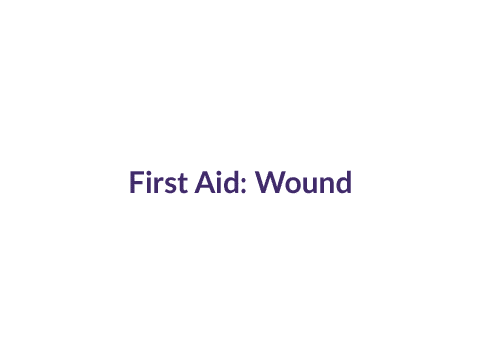Wounds, First Aid
A wound is any type of injury that breaks the skin. The severity can range from a small cut to a deep puncture wound. To prevent infection and promote healing, all wounds need care.
A scrape is when the surface of the skin is injured on a hard or rough surface, causing the skin to ooze and, often, bleed. A cut has a clean edge, while a tear has a jagged edge. Both cuts and tears can affect deep tissues (including muscles, tendons, and nerves) and are likely to bleed.
Wounds caused by a splinter or foreign object can be found in the Splinter and Foreign Object in Eye or Skin topics, respectively.
Who's At Risk?
Scrapes, cuts, tears, and puncture wounds can affect anyone.
Minor cuts and scrapes can happen at any time.
Signs & Symptoms
Scrapes are small blood vessels on the surface of the skin that have torn. They are usually shallow and may ooze blood. Dirt can sometimes be seen within the broken skin layers.
Cuts can be shallow or deep with a clean edge, such as from a knife cut. Tears have a rough, jagged edge. Cuts and tears are both likely to bleed. Tears are more likely to have dirt in them.
A puncture wound typically appears as a narrow but deep hole. It is often difficult to tell how deep a puncture wound is, and these types of wounds usually do not bleed much.
A wound caused by a foreign body may have an obvious object embedded in it (eg, a fishhook, splinter, zipper).
Self-Care Guidelines
First Aid Guide
A wound that is deep or bleeding heavily should not be cleaned right away because cleaning it may cause heavier bleeding.
The first step in care of a wound is to stop the bleeding.
- Locate the source of the bleeding.
- Wash your hands and, when possible, wear gloves or use a barrier between you and the wound.
- Remove any loose debris, but do not attempt to pull embedded debris from a wound.
- With a sterile or clean dressing, apply direct pressure.
- Unless a broken bone is suspected, elevate the injured area above the heart.
- If the dressing becomes soaked with blood, add a new dressing on top of the current dressing rather than replacing it.
If the bleeding does not stop after 15 minutes of the above measures, seek prompt medical care.
See the Shock topic if the person goes into shock.
The following information applies to first aid of wounds that are not deep and are not bleeding heavily.
General guidelines for cleaning and dressing a wound:
- Thoroughly wash the wound with mild soap and rinse with running water. Remove any loose debris, if present.
- Blot the wound dry with sterile gauze or a clean cloth.
- Bandage the wound with a sterile covering, making sure to cover the entire wound. Adhere the bandage snugly, but do not cut off circulation. Apply an antiseptic ointment or antiseptic solution, which helps reduce the risk of infection.
- Wash your hands.
- Watch for signs of infection in the coming days, such as swelling, redness, warmth, and oozing.
In the case of puncture wounds, applying an antiseptic solution is preferable to an antiseptic ointment.
First Aid Kit:
A first aid kit is important to have available for treating minor first aid situations on the spot and caring for more serious injuries until professional medical attention is available. Be sure you have a first aid kit that is properly stocked and that you are familiar with its contents.
Treatments
The medical professional will ensure the wound is clean and free of debris. Stitches, surgical glue, or surgical tape may be used if the opening of the wound is large, can’t easily be closed, or has fat or muscle protruding from it. The medical professional may also give a tetanus booster if the wound is dirty or deep, or if the previous immunization was more than 5 years ago.
Visit Urgency
Seek medical care in the case of a wound if:
- The bleeding is severe or cannot be stopped.
- The wound appears serious (eg, the wound is deep, possibly requires stitches, is from a human or animal bite, cannot be fully cleaned, or the person is experiencing loss of function or sensation).
- The pain associated with the wound is severe, even if the wound itself appears small.
- There is concern about scarring (eg, the wound is on the face or another highly visible area).
- The wound is on a joint, finger, or toe, as a tendon may be severed, causing loss of function.
- The person’s tetanus vaccination is not current.
Last modified on August 13th, 2024 at 11:49 am

Not sure what to look for?
Try our new Rash and Skin Condition Finder
